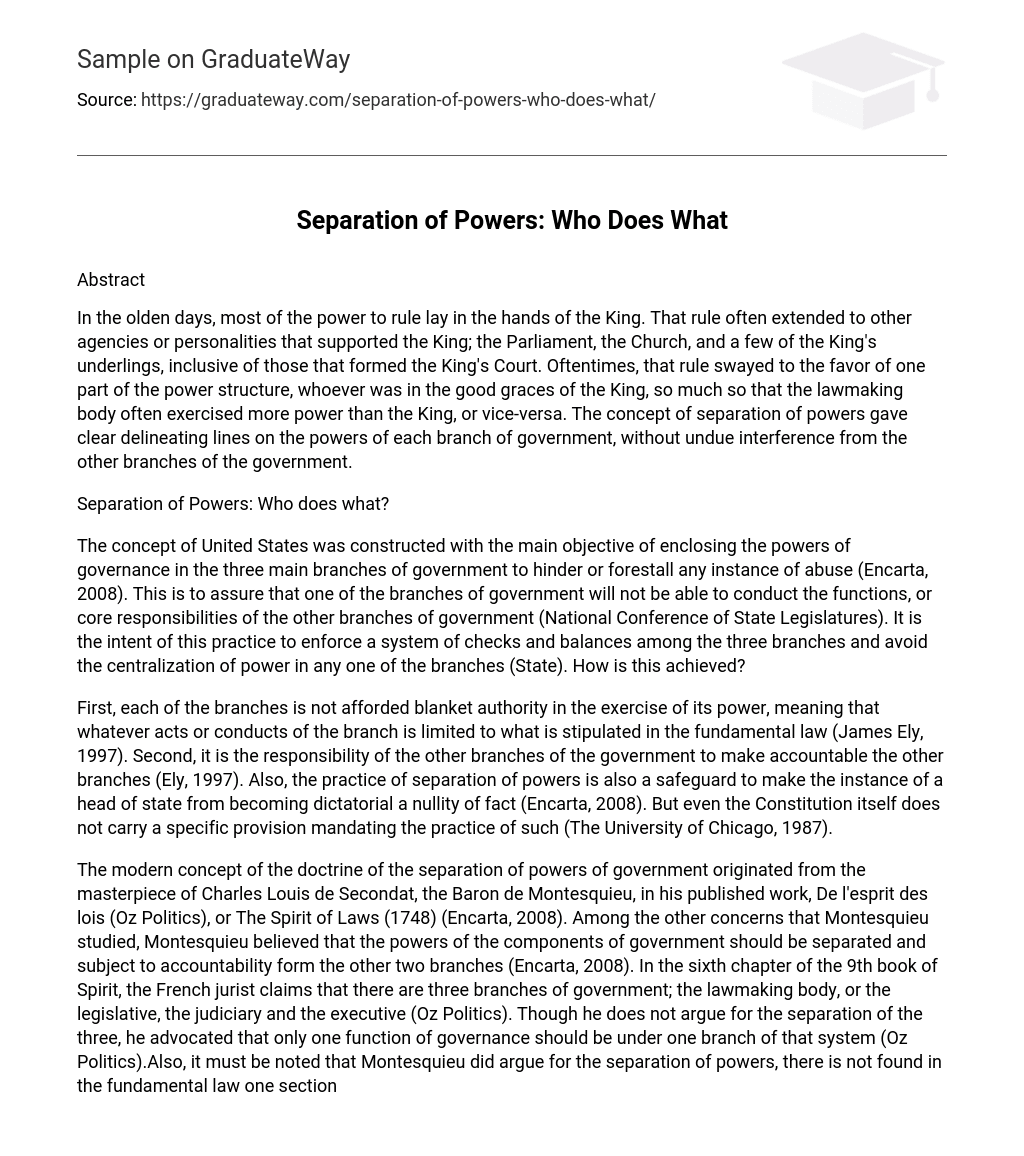Abstract
In the olden days, most of the power to rule lay in the hands of the King. That rule often extended to other agencies or personalities that supported the King; the Parliament, the Church, and a few of the King’s underlings, inclusive of those that formed the King’s Court. Oftentimes, that rule swayed to the favor of one part of the power structure, whoever was in the good graces of the King, so much so that the lawmaking body often exercised more power than the King, or vice-versa. The concept of separation of powers gave clear delineating lines on the powers of each branch of government, without undue interference from the other branches of the government.
Separation of Powers: Who does what?
The concept of United States was constructed with the main objective of enclosing the powers of governance in the three main branches of government to hinder or forestall any instance of abuse (Encarta, 2008). This is to assure that one of the branches of government will not be able to conduct the functions, or core responsibilities of the other branches of government (National Conference of State Legislatures). It is the intent of this practice to enforce a system of checks and balances among the three branches and avoid the centralization of power in any one of the branches (State). How is this achieved?
First, each of the branches is not afforded blanket authority in the exercise of its power, meaning that whatever acts or conducts of the branch is limited to what is stipulated in the fundamental law (James Ely, 1997). Second, it is the responsibility of the other branches of the government to make accountable the other branches (Ely, 1997). Also, the practice of separation of powers is also a safeguard to make the instance of a head of state from becoming dictatorial a nullity of fact (Encarta, 2008). But even the Constitution itself does not carry a specific provision mandating the practice of such (The University of Chicago, 1987).
The modern concept of the doctrine of the separation of powers of government originated from the masterpiece of Charles Louis de Secondat, the Baron de Montesquieu, in his published work, De l’esprit des lois (Oz Politics), or The Spirit of Laws (1748) (Encarta, 2008). Among the other concerns that Montesquieu studied, Montesquieu believed that the powers of the components of government should be separated and subject to accountability form the other two branches (Encarta, 2008). In the sixth chapter of the 9th book of Spirit, the French jurist claims that there are three branches of government; the lawmaking body, or the legislative, the judiciary and the executive (Oz Politics). Though he does not argue for the separation of the three, he advocated that only one function of governance should be under one branch of that system (Oz Politics).Also, it must be noted that Montesquieu did argue for the separation of powers, there is not found in the fundamental law one section that clearly declares that such a practice must be adhered to (Chicago, 1987). In reality, the term pertains to a term of legal discourse rather than a description of a practice (Answers, 2008). It is seen that no single entity among the three branches of the government can exercise their mandate apart from the other two branches (Answers, 2008). But the Constitution does stipulate that one entity in another branch cannot act as the implementer of the powers of another branch of government (Encarta, 2008).
The branches of government are therefore meant to be accountable to the other two. This is the basis of the “checks and balances” of the doctrine (Oz Politics). The checks and balances rule was intended to resolve the memories of an abusive monarchy, that of the English monarch George III (Answers, 2008). Some historians felt that the framers feared the uncivilized and uneducated citizenry (Answers, 2008). But the alleged prime motive for the institution of the practice was to secure certain interests to ensure support of the masses (Answers, 2008).
Also, the doctrine prevented the crafting of onerous legislation, as such will be subject to the judicial review powers of the Judicial branch (Ely, 1997). The crafters of the fundamental law, saw this possibility that the legislative branch, in their fears, would be an enterprise of sorts of the lawmakers (Ely, 1997). Arguing for this possibility, James Madison, one of the framers of the Constitution, propounded on the people that they must exhaust all means against the legislative branches imperial tendencies, which was supported by the other framers (Ely, 1997).
The power of whether that power of the executive or legislative branches has been laid by the crafters of the Constitution in the hands of the judiciary (Ely, 1997). It was not until that Justice John Marshall ruled on the unconstitutionality of an act of the executive when he ruled against the executive branch in the Marbury v Madison case (Gray, Burroughs, 1987). Judicial oversight requires that the acts of the two branches must adhere to the fundamental law, and to cure the instances of executive or legislative failure (Ely, 1997).
References
- Answers. (2008). Definition of separation of powers. Retrieved October 20, 2008, from http://www.answers.com/topic/separation-of-powers
- Ely, J.W. (1997). Property rights in American history. Oxford: Taylor & Francis http://books.google.com.ph/books?id=OdVyiw1ANycC
- Gray, L., Burroughs, W. (1987). Constitutional issues-separation of powers. Retrieved October 20, 2008, from http://www.archives.gov/education/lessons/separation-powers/
- MSN Encarta. (2008). Separation of powers. Retrieved October 20, 2008, fromhttp://encarta.msn.com/encyclopedia_761552394/Separation_of_Powers.html
- National Conference of State Legislatures. (n.d.). Separation of powers. Retrieved October 20, 2008, from http://www.ncsl.org/programs/legismgt/SeparationPowers.htm
- Oz Politics. (n.d.). Separation of powers. Retrieved October 20, 2008, fromhttp://www.ozpolitics.info/guide/rules/sep/
- University of Chicago. (1987). Separation of powers. The Founder’s Constitution Volume 1, chapter 10http://press-pubs.uchicago.edu/founders/documents/v1ch10I.html





